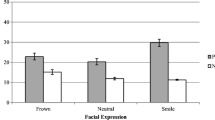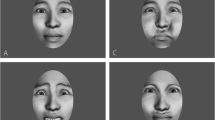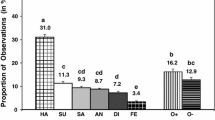Abstract
Spontaneous facial expressions were elicited from 64 young adults who watched video segments intended to evoke either positive or negative affect. Subjects viewed the stimuli under conditions where they were alone and thought they were not under visual surveillance. Expressive responses to the emotionally evocative materials were video-taped simultaneously from three perspectives (full-face, a 90° right profile, and a 90° left profile). A subset of facial expressions from 14 males and 14 females was selected and shown to 24 male and 24 female decoders. Judges viewed the expressions in one of the three facial perspectives (full-face, right hemiface, or left hemiface) in either normal or mirror-reversed orientation. Judgments were made for intensity and affective quality of the expressions. Positive expressions were more accurately identified in full-face and in right hemiface views as compared to left hemiface views, while the left hemiface was associated with better accuracy than the right hemiface for negative expressions. Right-looking profiles were associated with higher intensity ratings for both positive and negative affect. Among right-looking profiles, right hemiface expressions were seen as more intense than left hemiface expressions for positive affect. This was also true for full-face views. Full-face views were perceived as more intense for positive affect when the right hemiface was presented to the perceiver's right. This was true for negative expressions when the left hemiface was in the same position.
Similar content being viewed by others
References
Beaton, A. (1985).Left side, right side: A review of laterality research. New Haven: Yale University Press.
Buzby, D. E. (1924). The interpretation of facial expression.American Journal of Psychology, 35, 602–604.
Campbell, R. (1986). Asymmetries of facial action: Some facts and fancies of normal facial movement. In R. Bruyer (Ed.),The neuropsychology of face perception and facial expression (pp. 247–267). Hillsdale, NJ: Lawrence Erlbaum.
Davidson, R. J. (1984). Hemispheric asymmetry and emotion. In K. R. Scherer & P. Ekman (Eds.),Approaches to emotion (pp. 39–57). Hillsdale, NJ: Lawrence Erlbaum.
Davidson, R. J., Mednick, D., Moss, E., Saron, C., & Schaffer, C. E. (1987). Ratings of emotion in faces are influenced by the visual field to which stimuli are presented.Brain and Cognition, 6, 403–411.
Davidson, R. J., Schaffer, C. E., & Saron, C. (1985). Effects of lateralized presentations of faces on self-reports of emotion and EEG asymmetry in depressed and non-depressed subjects.Psychophysiology, 22, 353–364.
Ekman, P. (1972). Universals and cultural differences in facial expression of emotion. In J. Cole (Ed.),Nebraska Symposium on Motivation (Vol. 19, pp. 207–283). Lincoln: University of Nebraska Press.
Ekman, P., & Friesen, W. V. (1976).Pictures of facial affect. Palo Alto, CA: Consulting Psychologists Press.
Ekman, P., Friesen, W. V., & Ancoli, S. (1980). Facial signs of emotional experience.Journal of Personality and Social Psychology, 39, 1125–1134.
Fridlund, A. J. (1988). What can asymmetry and laterality in EMG tell us about the face and brain?International Journal of Neuroscience, 39, 53–69.
Fridlund, A. J., Ekman, P., & Oster, H. (1987). Facial expressions of emotion. In A. Siegman and S. S. Feldstein (Eds.),Nonverbal behavior and communication (2nd ed., pp. 143–224). Hillsdale, NJ: Lawrence Erlbaum.
Grega, D. M., Sackeim, H. A., Sanchez, E., Cohen, B. H., & Hough, S. (1988). Perceiver bias in the processing of human faces: Neuropsychological mechanisms.Cortex, 24, 91–117.
Hager, J. C., & Ekman, P. (1985). The asymmetry of facial actions is inconsistent with models of hemispheric specialization.Psychophysiology, 22, 307–318.
Izard, C. E. (1971).The face of emotion. New York: Appleton-Century-Crofts.
Jarden, E., & Fernberger, S. W. (1926). The effect of suggestion on the judgment of facial expression of emotion.American Journal of Psychology, 37, 565–570.
Lanzetta, J. T., & Kleck, R. E. (1970). Encoding and decoding of facial affect in humans.Journal of Personality and Social Psychology, 16, 12–19.
Sackeim, H. A., & Gur, R. C. (1983). Facial asymmetry and the communication of emotion. In J. T. Cacioppo & R. E. Petty (Eds.),Social psychophysiology: A sourcebook (pp. 307–352). New York: Guilford Press.
Author information
Authors and Affiliations
Additional information
The research reported here was supported in part by funds associated with the John Sloan Dickey Third Century Professorship in the Social Sciences, the Faculty Research Fund of Dartmouth College, and a Spoor Grant to Dartmouth College. Aspects of this research were presented at the American Psychological Association Meeting in New Orleans, August, 1989.
The authors would like to thank Joanna Champion-Young and Brian Young for their help in selecting the expressive stimuli used in this study. We are also grateful to Dr. Alan J. Fridlund and Dr. Harold Wallbott for comments on an earlier version of this manuscript.
Rights and permissions
About this article
Cite this article
Kleck, R.E., Mendolia, M. Decoding of profile versus full-face expressions of affect. J Nonverbal Behav 14, 35–49 (1990). https://doi.org/10.1007/BF01006578
Issue Date:
DOI: https://doi.org/10.1007/BF01006578




